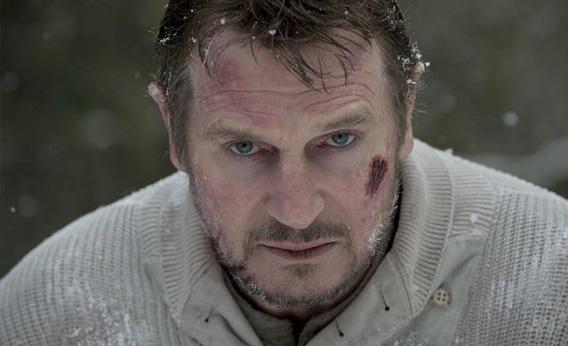Joe Carnahan’s The Grey (Open Road Films) provides everything you could reasonably want from a January release about Liam Neeson fighting wolves. That may sound like faint praise, but the truth is, I pretty much loved this movie from start to finish—risible implausibilities, insufficiently explained premise and all. An admirably spare survival thriller, The Grey (nice title!) abounds in qualities that are rare in movies of its type. It’s quiet, contemplative, and almost haiku-like in its simplicity.
“Haiku-like” is a curious adjective to find oneself applying to a movie with multiple graphic scenes of human and lupine evisceration. I don’t mean to suggest that The Grey is some sort of chin-stroking art film—if you’re in it for the Neeson-on-wolf action, you will be amply provided for. But this efficient man vs. nature battle fantasy also doubles as a surprisingly somber meditation on some pretty huge (and unanswerable) questions: When disaster strikes, why do some people live and others die? What kind of debt do the living owe the dead? How is it possible to maintain one’s faith, or even the courage to keep going, in the midst of great grief and suffering? When, if ever, is it the right time to just give up?
Giving up is not something that comes easy to The Grey’s hero, Ottway, played by Neeson. (We won’t learn the character’s first name until a key scene near the movie’s end.) Ottway works as a sharpshooter at a remote oil-drilling outpost in Alaska, picking off wolves that come close enough to endanger the workers. That job description is pretty much all we know about Ottway, other than the fact that he’s suicidal: After writing a note to a lost love addressed only as “Dearest One,” he prepares to shoot himself with his own rifle, but takes the gun out of his mouth when he hears a wolf howl close by. Does Ottway choose to go on living at that moment because he’s reminded of his moral duty to protect his fellow workers, because he doesn’t want a wolf to scavenge his corpse the moment he dies, or for some other reason? It’s never clear, but his commitment to survival is about to be put to an even harsher test.
The next day (for reasons that also remain vague), Ottway and a group of men from the drilling site board a plane to Anchorage. The plane crashes, in a scene that’s all the more frightening for being unadornedly realistic—no suspenseful music or clever editing, just a lot of screaming people in a metal tube falling through space. Only seven men survive the wreck—a tally that will rapidly begin to diminish as the survivors discover they’ve landed on the hunting grounds of a pack of highly territorial wolves. In a choice that may have been financially motivated but turned out to be aesthetically smart, Carnahan barely shows the wolves at all. What we do see of the predatory pack is a combination of CGI, puppet animation, and trained live animals. But with the memorable exception of a few scary fight scenes, we experience the wolves mainly in the form of ungodly offscreen howls and green, glowing eyes in the dark.
As the group’s resident wolf expert and all-around badass, Ottway soon becomes their de facto leader. This does not sit well with Diaz (Frank Grillo), a blustering, macho ex-con who challenges Ottway’s quiet authority at every turn. Among the other survivors are family man Talget (an unrecognizable, and terrific, Dermot Mulroney), cowardly loudmouth Flannery (an amusingly hyper Joe Anderson), and the mysteriously taciturn Henrick (Dallas Roberts). For no other reason than to do something about their hideous plight, the men resolve to trek across the tundra to a distant tree-lined mountain, hoping to encounter either civilization or at least better cover along the way.
From there on in, almost nothing can be revealed about the central question gripping both the audience and these frightened men: Which of them will live and which will die? The Grey’s obsessive focus on this question, along with its episodic bouts of sudden, gruesome violence, may make it seem to some viewers like a sadistic pick-’em-off exploitation film. But, unlike in Carnahan’s earlier film Smokin’Aces (he also directed Narc and The A-Team), every death in The Grey is experienced as a singular, tragic, and unrepeatable event: That person who was there a minute ago is gone. There’s an extraordinary scene early on in which, just after the crash, Neeson’s character gently encourages a dying man to let go and accept his fate as his fellow survivors look on in stunned horror. An hour in, you start to realize that that small but powerful moment was a template for the entire movie.
The latest chapter in Liam Neeson’s remarkable late-career self-reinvention as a credible and magnetic action hero—the man is, get this, ladies, nearly 60 years old—The Grey can’t help but evoke memories of Neeson’s real-life tragedy, the loss of his wife Natasha Richardson in a freak skiing accident in 2009. From the aching letter Ottway writes to an absent beloved in the film’s early scenes, to the many moments he must adjust himself to a new reality of mourning as his companions die one by one, this is a movie not only about death but about grief. Carnahan has said that the younger men he considered for the part “didn’t understand their own mortality.” Neeson brings that hard-won understanding to painfully vivid life on-screen, turning what could have been a stock manly-man role into something much deeper and richer.
For all its macho standoffs and action set pieces and menacing off-screen howling, The Grey is at heart a simple moral fable about how true heroism consists in helping other human beings to live as long and die as well as they can, which is, after all, the task all of us face each day, even when we’re not fending off wolves with broken glass duct-taped to our knuckles.
